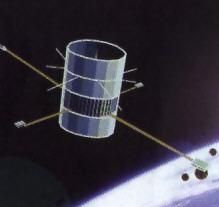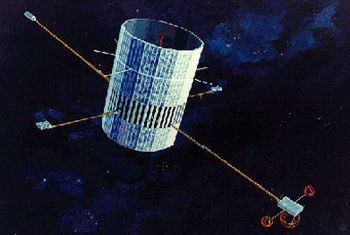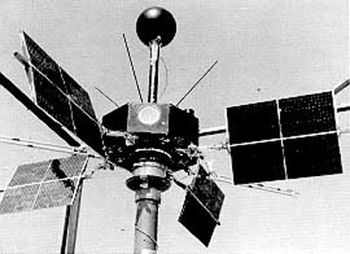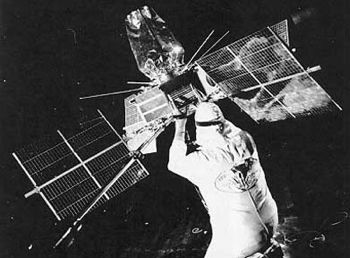
Home - Search - Browse - Alphabetic Index: 0- 1- 2- 3- 4- 5- 6- 7- 8- 9
A- B- C- D- E- F- G- H- I- J- K- L- M- N- O- P- Q- R- S- T- U- V- W- X- Y- Z
IMP
 IMP-8 / Explorer 50 Credit: NASA |
AKA: Interplanetary Monitoring Platform. Status: Operational 1963. First Launch: 1963-11-27. Last Launch: 1973-10-26. Number: 10 . Gross mass: 62 kg (136 lb).
The IMP series were managed by the Goddard Space Flight Center with the primary objectives of investigation of interplanetary plasma and the interplanetary magnetic field. The orbiting of IMP satellites in a variety of interplanetary and earth orbits allowed study of spatial and temporal relationships of geophysical and interplanetary phenomena simultaneously by several other National Aeronautics and Space Administration satellites. The IMP network provided a crucial 'early warning network' of solar flare activity for Apollo manned missions that ventured beyond the Van Allen Radiation Belts.
NASA NSSDC Master Catalog Description
This spacecraft was placed into a high-inclination, highly eccentric earth orbit. The apogee point was located near the ecliptic plane and had an initial local time of about 1900 h. The spacecraft was spin-stabilized and had an initial spin period of 2.6 s. The spin vector was approximately perpendicular to the ecliptic plane. Like the earlier IMPs, this spacecraft was instrumented to study interplanetary magnetic fields, energetic particles, and plasma. The spacecraft optical aspect system failed on 04 March 1969. Otherwise, useful data were acquired until just before spacecraft reentry, which occurred on 03 May 1969.
NASA NSSDC Master Catalog Description
IMP-I continued the study, begun by earlier IMPs, of the interplanetary and outer magnetospheric regions by measuring energetic particles, plasma, and electric and magnetic fields. A radio astronomy experiment was also included in the spacecraft payload. The 16-sided spacecraft was 182.12 cm high by 135.64 cm in diameter. The spacecraft spin axis was normal to the ecliptic plane, and its spin rate was 5 rpm. The initial apogee point lay near the earth-sun line. The solar-cell and chemical-battery powered spacecraft carried two transmitters. One continuously transmitted PCM encoder data at a 1600-bps information bit rate. The second transmitter was used for transmission of VLF data and for ranging information. Three orthogonal pairs of dipole antennas were used for the electric fields experiments, and one of these pairs was also used for the radio astronomy experiment. The members of the antenna pair along the spacecraft spin axis extended 2.9 m, the members of the pair used in both the electric field and radio astronomy experiments extended 45.5 m, and the members of the third pair were slightly unbalanced, extending 24.4 and 27.6 m, respectively. All four elements perpendicular to the spin axis were to have extended 45.5 m. The spacecraft reentered the earth's atmosphere October 2, 1974, after a highly successful mission.
NASA NSSDC Master Catalog Description
Explorer 28 (IMP 3) was a solar-cell and chemical-battery powered spacecraft instrumented for interplanetary and distant magnetospheric studies of energetic particles, cosmic rays, magnetic fields, and plasmas. Initial spacecraft parameters included a local time of apogee of 2020 h, a spin rate of 23.7 rpm, and a spin direction of 64.9-deg right ascension and -10.9-deg declination. Each normal telemetry sequence was 81.9 s in duration and consisted of 795 data bits. After every third normal telemetry sequence there was an 81.9-s interval of rubidium vapor magnetometer analog data transmission. Performance was essentially normal until late April 1967, then intermittent until May 12, 1967, after which no further data were acquired.
NASA NSSDC Master Catalog Description
Explorer 41 (IMP-G) was a spin-stabilized spacecraft placed into a high-inclination, highly elliptic orbit to measure energetic particles, magnetic fields, and plasma in cislunar space. The line of apsides and the satellite spin vector were within a few degrees of being parallel and normal, respectively, to the ecliptic plane. Initial local time of apogee was about 1300 h. Initial satellite spin rate was 27.5 rpm. The basic telemetry sequence was 20.48 s. The spacecraft functioned very well from launch until it decayed from orbit on December 23, 1972. Data transmission was nearly 100% for the spacecraft life except for the interval from November 15, 1971, to February 1, 1972, when data acquisition was limited to the vicinity of the magnetotail neutral sheet.
NASA NSSDC Master Catalog Description
IMP-H continued the study begun by earlier IMP spacecraft of the interplanetary and magnetotail regions from a nearly circular orbit, near 37 earth radii. This 16-sided drum-shaped spacecraft was 157 cm high and 135 cm in diameter. It was designed to measure energetic particles, plasma, and electric and magnetic fields. The spin axis was normal to the ecliptic plane, and the spin period was 1.3 s. The spacecraft was powered by solar cells and a chemical battery. Scientific data were telemetered at 1600 bps (with a secondary 400-bps rate available). The spacecraft was turned off on October 31, 1978.
NASA NSSDC Master Catalog Description
IMP 8 (Explorer 50), the last satellite of the IMP series, was a drum-shaped spacecraft, 135.6 cm across and 157.4 cm high, instrumented for interplanetary and magnetotail studies of cosmic rays, energetic solar particles, plasma, and electric and magnetic fields. Its initial orbit was more elliptical than intended, with apogee and perigee distances of about 45 and 25 earth radii. Its eccentricity decreased after launch. Its orbital inclination varied between 0 deg and about 55 deg with a periodicity of several years. The spacecraft spin axis was normal to the ecliptic plane, and the spin rate was 23 rpm. The data telemetry rate was 1600 bps. The spacecraft was in the solar wind for 7 to 8 days of every 12.5 day orbit. Telemetry coverage was 90% in the early years, but only 60-70% through most of the 1980's and early 1990's. Coverage returned to the 90% range in the mid to late 1990's. The objectives of the extended IMP-8 operations were to provide solar wind parameters as input for magnetospheric studies and as a 1-AU baseline for deep space studies, and to continue solar cycle variation studies with a single set of well-calibrated and understood instruments. In October, 2001, IMP 8 was terminated as an independent mission. Telemetry acquisition resumed after about three months at Canberra only (30-50% coverage), as an adjunct to the Voyager and Ulysses missions. Last useful science data from IMP 8 was acquired on October 7, 2006.
NASA NSSDC Master Catalog Description
Explorer 18 (IMP 1) was a solar-cell and chemical-battery powered spacecraft instrumented for interplanetary and distant magnetospheric studies of energetic particles, cosmic rays, magnetic fields, and plasmas. Initial spacecraft parameters included a local time of apogee of 1020 h, a spin rate of 22 rpm, and a spin direction of 115 deg right ascension and -25 deg declination. Each normal telemetry sequence of 81.9 s duration consisted of 795 data bits. After every third normal sequence there was an 81.9-s interval of rubidium vapor magnetometer analog data transmission. The spacecraft performed normally until May 30, 1964, then intermittently until May 10, 1965, when it was abandoned. The principal periods of data coverage were November 27, 1963 to May 30, 1964; September 17, 1964 to January 7, 1965; and February 21, 1965 to March 25, 1965; however, only the first of these periods was very useful.
NASA NSSDC Master Catalog Description
Explorer 21 (IMP 2) was a solar-cell and chemical-battery powered spacecraft instrumented for interplanetary and distant magnetospheric studies of energetic particles, cosmic rays, magnetic fields, and plasmas. Each normal telemetry sequence of 81.9 s in duration consisted of 795 data bits. After every third normal sequence there was an 81.9-s interval of rubidium vapor magnetometer analog data transmission. Initial spacecraft parameters included a local time of apogee at noon, a spin rate of 14.6 rpm, and a spin direction of 41.4-deg right ascension and 47.4-deg declination. The significant deviation of the spin rate and direction from the planned values and the achievement of an apogee of less than half the planned value adversely affected data usefulness. Otherwise, spacecraft systems performed well, with nearly complete data transmission for the first 4 months and for the sixth month after launch. Data transmission was intermittent for other times, and the final transmission occurred on October 13, 1965.
More at: IMP.
| IMP D, E (LAIMP 1, 2) Null |
| IMP F, G Research, Magnetosphere satellite operated by NASA, USA. Launched 1967 - 1969. |
| IMP H, I, J Research, Magnetosphere satellite operated by NASA, USA. Launched 1971 - 1973. |
Family: Earth, High earth orbit, Magnetosphere sat. Country: USA. Launch Vehicles: Thor, Delta, Thor Delta C, Thor Delta E, Thor Delta E1, Thor Delta M, Thor Delta M6, Delta 1604, Delta 1000, Delta C. Projects: Explorer. Launch Sites: Cape Canaveral, Vandenberg, Cape Canaveral LC17B, Cape Canaveral LC17A, Vandenberg SLC2E, Vandenberg SLC2W. Agency: NASA, NASA Greenbelt. Bibliography: 16, 2, 279, 3695, 3697, 3698, 3707, 3714, 3716, 3719, 3720, 3722, 3725, 3726, 3727, 3730, 3731, 3733, 405, 6, 11218, 12650, 12651, 12652, 12653.
 | Explorer 47 Credit: Manufacturer Image |
 | Explorer 18 Credit: Manufacturer Image |
 | Explorer 28 Credit: Manufacturer Image |
 | Explorer 34 Credit: Manufacturer Image |
 | IMP-A Credit: NASA |
1963 November 27 - . 02:30 GMT - . Launch Site: Cape Canaveral. Launch Complex: Cape Canaveral LC17B. LV Family: Thor. Launch Vehicle: Thor Delta C.
- Explorer 18 - . Payload: IMP A. Mass: 62 kg (136 lb). Nation: USA. Agency: NASA Greenbelt. Program: Explorer. Class: Earth. Type: Magnetosphere satellite. Spacecraft: IMP. Decay Date: 1965-11-30 . USAF Sat Cat: 693 . COSPAR: 1963-046A. Apogee: 197,616 km (122,792 mi). Perigee: 192 km (119 mi). Inclination: 33.30 deg. Period: 5,666.20 min. Radiation data; Interplanetary Monitoring Program. Spacecraft engaged in research and exploration of the upper atmosphere or outer space (US Cat B). .
1964 October 4 - . 03:45 GMT - . Launch Site: Cape Canaveral. Launch Complex: Cape Canaveral LC17A. LV Family: Thor. Launch Vehicle: Thor Delta C.
- Explorer 21 - . Payload: IMP B. Mass: 62 kg (136 lb). Nation: USA. Agency: NASA Greenbelt. Program: Explorer. Class: Earth. Type: Magnetosphere satellite. Spacecraft: IMP. Decay Date: 1965-12-31 . USAF Sat Cat: 889 . COSPAR: 1964-060A. Apogee: 95,590 km (59,390 mi). Perigee: 191 km (118 mi). Inclination: 33.50 deg. Period: 2,097.00 min. Lower than planned orbit. Spacecraft engaged in research and exploration of the upper atmosphere or outer space (US Cat B). .
1965 May 4 - .
- Three-station Apollo Solar Particle Alert Network ordered - .
Nation: USA.
Program: Apollo.
Spacecraft: IMP.
NASA Associate Administrator for Manned Space Flight George E. Mueller concurred with a plan of MSC Director Robert R. Gilruth to implement a three-station developmental Solar Particle Alert Network. Mueller said he understood that Gilruth would "review the necessity for the Guaymas station, and that you will examine having all data reduction related to this network carried out under contract," and adding that he felt the program would be enhanced if arrangement could be made to involve one or more academic institutions in the analysis of data.
1965 May 29 - . 12:00 GMT - . Launch Site: Cape Canaveral. Launch Complex: Cape Canaveral LC17B. LV Family: Thor. Launch Vehicle: Thor Delta C.
- Explorer 28 - . Payload: IMP C. Mass: 58 kg (127 lb). Nation: USA. Agency: NASA Greenbelt. Program: Explorer. Class: Earth. Type: Magnetosphere satellite. Spacecraft: IMP. Decay Date: 1968-07-04 . USAF Sat Cat: 1388 . COSPAR: 1965-042A. Apogee: 261,206 km (162,305 mi). Perigee: 229 km (142 mi). Inclination: 30.50 deg. Period: 8,419.70 min. Magnetic field, radiation data. Spacecraft engaged in research and exploration of the upper atmosphere or outer space (US Cat B). .
1966 July 1 - . 16:02 GMT - . Launch Site: Cape Canaveral. Launch Complex: Cape Canaveral LC17A. LV Family: Thor. Launch Vehicle: Thor Delta E1.
- Explorer 33 - . Payload: AIMP D. Mass: 93 kg (205 lb). Nation: USA. Agency: NASA Greenbelt. Program: Explorer. Class: Earth. Type: Magnetosphere satellite. Spacecraft: IMP. USAF Sat Cat: 2258 . COSPAR: 1966-058A. Apogee: 480,762 km (298,731 mi). Perigee: 265,679 km (165,084 mi). Inclination: 24.10 deg. Period: 38,792.40 min. Intended to enter lunar orbit. Spacecraft engaged in research and exploration of the upper atmosphere or outer space (US Cat B). .
1967 May 24 - . 14:05 GMT - . Launch Site: Vandenberg. Launch Complex: Vandenberg SLC2E. LV Family: Thor. Launch Vehicle: Thor Delta E1.
- Explorer 34 - . Payload: IMP F. Mass: 75 kg (165 lb). Nation: USA. Agency: NASA Greenbelt. Program: Explorer. Class: Earth. Type: Magnetosphere satellite. Spacecraft: IMP. Decay Date: 1969-05-03 . USAF Sat Cat: 2817 . COSPAR: 1967-051A. Apogee: 214,379 km (133,208 mi). Perigee: 242 km (150 mi). Inclination: 67.10 deg. Period: 6,358.20 min. Radiation, magnetic field data. Spacecraft engaged in research and exploration of the upper atmosphere or outer space (US Cat B). .
1967 July 19 - . 14:19 GMT - . Launch Site: Cape Canaveral. Launch Complex: Cape Canaveral LC17B. LV Family: Thor. Launch Vehicle: Thor Delta E1.
- Explorer 35 - .
Payload: AIMP E. Mass: 104 kg (229 lb). Nation: USA.
Agency: NASA Greenbelt.
Program: Explorer.
Class: Earth.
Type: Magnetosphere satellite. Spacecraft: IMP.
USAF Sat Cat: 2884 . COSPAR: 1967-070A. Apogee: 675 km (419 mi). Perigee: 484 km (300 mi). Inclination: 32.40 deg. Period: 96.26 min.
Earth magnetic tail measurements. Lunar Orbit (Selenocentric). The Westinghouse Aerospace Division, under contract to National Aeronautics and Space Administration's Goddard Space Flight Center, engaged in the system design, integration, assembly and launch support for Anchored Interplanetary Monitoring Platform Satellite, officially designated Explorer 35 by the National Aeronautics and Space Administration. It was launched on July 19, 1967, with the primary objectives of investigation of interplanetary plasma and the interplanetary magnetic field out to and at the lunar distance, in either a captured lunar orbit or a geocentric orbit of the earth. In the geocentric orbit, the apogee was near or beyond the lunar distance. In a lunar orbit, additional objectives included obtaining data on dust distribution, lunar gravitational field, ionosphere, magnetic field, and radiation environment around the moon. AIMP-E also studied spatial and temporal relationships of geophysical and interplanetary phenomena simultaneously being studied by several other National Aeronautics and Space Administration satellites. The investigation in the vicinity of the moon provided for measurements of the characteristics of the interplanetary dust distribution, solar and galactic cosmic rays, as well as a study of the magnetohydrodynamic wake of the earth in the interplanetary medium at the lunar distances.
1969 June 21 - . 08:47 GMT - . Launch Site: Vandenberg. Launch Complex: Vandenberg SLC2W. LV Family: Thor. Launch Vehicle: Thor Delta E1.
- Explorer 41 - . Payload: IMP G. Mass: 174 kg (383 lb). Nation: USA. Agency: NASA Greenbelt. Program: Explorer. Class: Earth. Type: Magnetosphere satellite. Spacecraft: IMP. Decay Date: 1972-12-23 . USAF Sat Cat: 3990 . COSPAR: 1969-053A. Apogee: 98,159 km (60,993 mi). Perigee: 80,374 km (49,941 mi). Inclination: 86.00 deg. Period: 4,906.30 min. Cislunar radiation data. Spacecraft engaged in research and exploration of the upper atmosphere or outer space (US Cat B). .
1971 March 13 - . 16:15 GMT - . Launch Site: Cape Canaveral. Launch Complex: Cape Canaveral LC17A. LV Family: Thor. Launch Vehicle: Thor Delta M6.
- Explorer 43 - .
Payload: IMP I. Mass: 288 kg (634 lb). Nation: USA.
Agency: NASA Greenbelt.
Program: Explorer.
Class: Earth.
Type: Magnetosphere satellite. Spacecraft: IMP.
Decay Date: 1974-10-02 . USAF Sat Cat: 5043 . COSPAR: 1971-019A. Apogee: 203,130 km (126,210 mi). Perigee: 1,845 km (1,146 mi). Inclination: 31.20 deg. Period: 5,957.90 min.
In its first use at Cape Canaveral, a NASA Long Tank Thrust Augmented Thor/ Delta boosted Explorer 43 into orbit. This was the first "Super Six" configuration Thor/Delta, with strap-on solid-rocket boosters motors, to be launched from the Eastern Test Range. Earth magnetosphere research. Spacecraft engaged in research and exploration of the upper atmosphere or outer space (US Cat B).
1972 September 23 - . 01:20 GMT - . Launch Site: Cape Canaveral. Launch Complex: Cape Canaveral LC17B. LV Family: Thor. Launch Vehicle: Delta 1604.
- Explorer 47 - . Payload: IMP H. Mass: 376 kg (828 lb). Nation: USA. Agency: NASA Greenbelt. Program: Explorer. Class: Earth. Type: Magnetosphere satellite. Spacecraft: IMP. USAF Sat Cat: 6197 . COSPAR: 1972-073A. Apogee: 235,600 km (146,300 mi). Perigee: 201,100 km (124,900 mi). Inclination: 17.20 deg. Period: 17,670.00 min. Investigated cislunar radiation, Earth's magnetosphere, interplantary magnetic field. Spacecraft engaged in practical applications and uses of space technology such as weather or communication (US Cat C). .
1973 October 26 - . 02:26 GMT - . Launch Site: Cape Canaveral. Launch Complex: Cape Canaveral LC17B. LV Family: Thor. Launch Vehicle: Delta 1604.
- Explorer 50 - . Payload: IMP J. Mass: 371 kg (817 lb). Nation: USA. Agency: NASA Greenbelt. Program: Explorer. Class: Earth. Type: Magnetosphere satellite. Spacecraft: IMP. USAF Sat Cat: 6893 . COSPAR: 1973-078A. Apogee: 244,361 km (151,838 mi). Perigee: 190,749 km (118,525 mi). Inclination: 31.60 deg. Period: 17,576.70 min. Solar flare and radiation monitor. Spacecraft engaged in research and exploration of the upper atmosphere or outer space (US Cat B). .
Back to top of page
Home - Search - Browse - Alphabetic Index: 0- 1- 2- 3- 4- 5- 6- 7- 8- 9
A- B- C- D- E- F- G- H- I- J- K- L- M- N- O- P- Q- R- S- T- U- V- W- X- Y- Z
© 1997-2019 Mark Wade - Contact
© / Conditions for Use